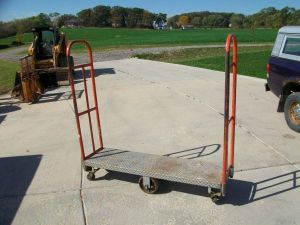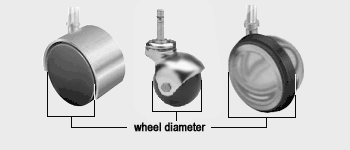Ridin’ on Thirties: Measuring caster height

The casters on carts like this are uneven on purpose. It’s OK to do it wrong as long as you meant to.
So you need a caster, eh? Lemme guess: You broke another chair. If I weren’t such a dedicated salesman, I’d suggest that a trip or two the gym might be more in order than a new caster. But I don’t get paid to sell gym memberships, so it’s my solemn responsibility to help you replace your suicidal chair casters.
First things first: you know you need a caster, but do you know which caster you need? There’s a surprising number of options. Typically you’ll want to try and match what you’ve already got, so you’ll want to start by measuring the caster. Unless you want your chair to function like a Home Depot lumber cart (hint: you probably don’t).
Caster height is fairly straightforward – measure from the bottom (where the wheel touches the ground) up to the highest point on the caster. UNLESS. Unless your caster has a stem – a small metal dowel thingy that inserts into receiving holes on both the caster and the chair. If you have a stem, you want to measure up to the base of the stem. Here’s a helpful diagram the boys in the lab threw together:
Reason being, stems are variable – the same size caster can have any of several different stem lengths. So you’ll also want to measure that stem length.
Jot down both numbers. You’ve done quite well. I’d be proud of you if this wasn’t so blindingly easy.
The other dimension you’ll need is the diameter of the wheel itself. Carefully follow these steps:
1. Take your tape measure firmly in your hands.
2. Place one end of the tape on one edge of the wheel.
3. Note where the other edge of the wheel lands on the tape.
4. DO NOT simply allow the tape to slide back into the measure, the chances of a fatal tape measure cut are simply too high.
This is trickier if you’re using ball casters; you’ll have to guesstimate the edges (or get clever and use a vice or something). Here’s another helpful diagram. Those lab boys are wizards with this stuff:

If you have one of those strange ball casters, you should feel bad, because you’re mostly alone in the world.
Once you’ve got those dimensions (caster height, wheel diameter, and stem height if applicable), you’ve got the measurements you need to match your caster with a replacement. There’s also caster type, color, material, and capacity to consider, but I’ll go over those later. Baby steps.
Lastly, should you decide to go nuclear and replace the entire set of casters instead of just matching one or two with the rest, remember that larger casters roll easier. If you’re packing a few hundred pounds of raw muscle and have a habit of pumping iron at your desk, I both fear you and recommend you consider a larger caster – move up to a 2-1/2″ from a 2″ for example. You’ll be able to push yourself across the floor easier, thus resulting in more workplace satisfaction.
Check out Wheel and Caster 101 for more info.
Wheel and Caster is a locally owned business located in Spokane, Washington. We ship all over the country and strive to provide quick, helpful service. Wheel and Caster is a division of Norlift, Inc, which is also a pretty cool place. You can read more about it at the Norlift blog.

